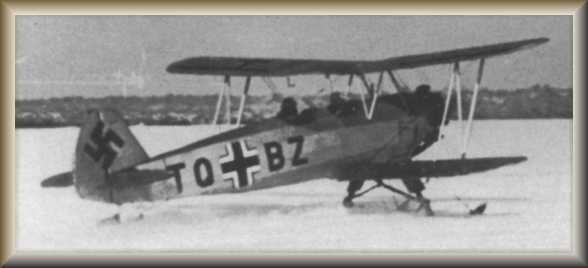
Februar 17, 1940, Focke-Wulf 44 TQ![]() BZ,
first lesson and take off
BZ,
first lesson and take off
at Schönwalde
> ![]()
june 1941 6./JG52
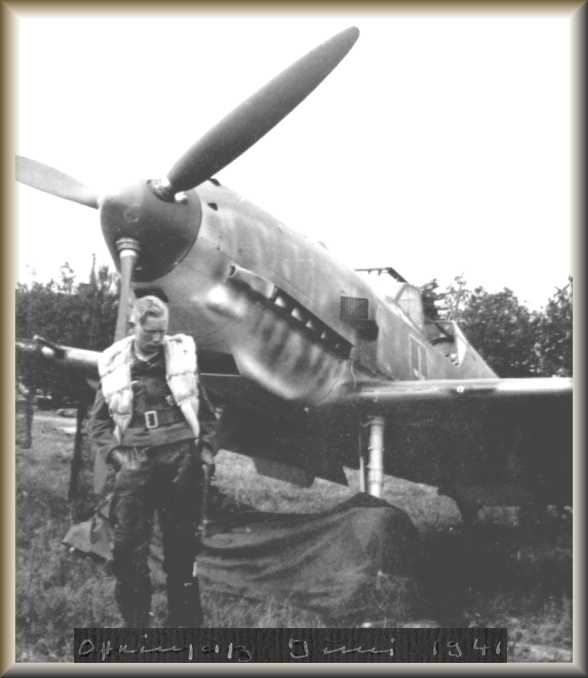
Messerschmitt Bf 109 E-4/B 6Wnr. ? from 6./JG52, 2nd Lt. Heinz Knoke, june 1941
August, 1941, 2./JG1
(detail from picture above)
Messerschmitt Bf 109 E-4 "Lilo" 3Wnr.? from 2./JG1, August, 1941
This plane will be damaged in a forced landing on a frozen Norwegian lake.
August 16, 1941, 3./JG1
Messerschmitt Bf 109 F-2 7
Wnr.12866 from 3./JG1, damaged by Lt. Heinz Knoke, 16th August 1941
in Husum >
Autumn, 1941, 2./JG1
Messerschmitt Bf 109 E-4 3
Wnr.? from 2./JG1, Lt. Heinz Knoke and Uffz. Wolf, Autumn, 1941
in Jever >
This plane will be damaged in a forced landing on a frozen Norwegian lake.
Winter, 1941 / 1942, 2./JG1
Messerschmitt Bf 109 F-2 Wnr.? from 2./JG1, tried by Lt. Heinz Knoke, Winter, 1941 / 1942
in Jever >
This aircraft is probably one of the first Friedrichs of the 2./JG1.
In March 6, 1942, 2./JG"Losigkeit"

Messerschmitt Bf 109 E-4 3![]() Wnr.? from
"Losgkeit" Gruppe, Lt.
Heinz Knoke,
Wnr.? from
"Losgkeit" Gruppe, Lt.
Heinz Knoke,
after landing on a frozen Norwegian lake (exact
location still unknown),
due to pressure fuel feed problems, March 6, 1942.
September, 1942 2./JG1
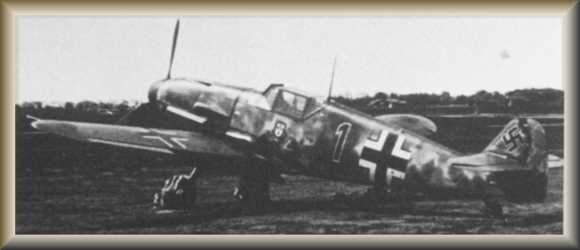
Messerschmitt Bf 109 F-4
1![]() Wnr.? from 2./JG1, Lt. Heinz Knoke, September 1942
Wnr.? from 2./JG1, Lt. Heinz Knoke, September 1942
in Jever >
![]()
Based on Deelen airfield from June to early September
1942,
Heinz Knoke was in charge (That's why a 1)
of a "Schwarm" (4 aircrafts)
which task was to calibrate a new radio guide system
: FuG 16 Y-Fürhung.
Long caracteristic antenna is fixed over Knoke's plane.
Below, on the plan , one can see the second little antenna under the aircraft.
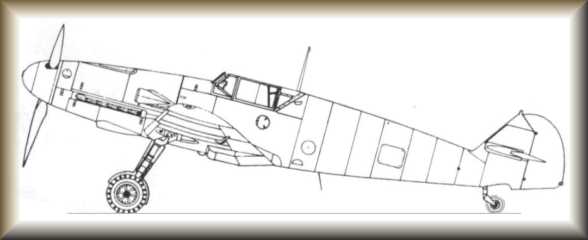
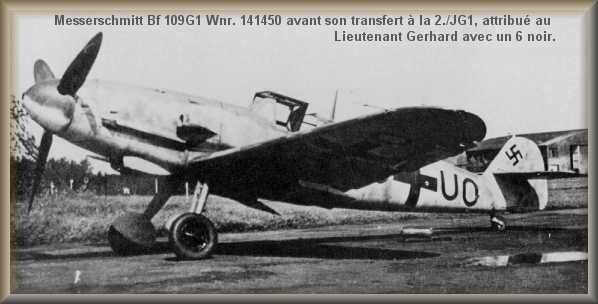
April 1943, 5./JG11
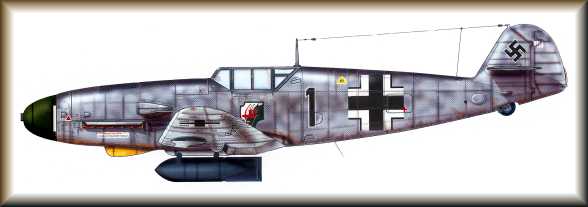
Messerschmitt Bf 109 G-1
1![]() 5./JG11, Lieutnant Heinz Knoke, Staffelkapitän, April, 1943
5./JG11, Lieutnant Heinz Knoke, Staffelkapitän, April, 1943
in Jever
> ![]()
April 1943, 5./JG11
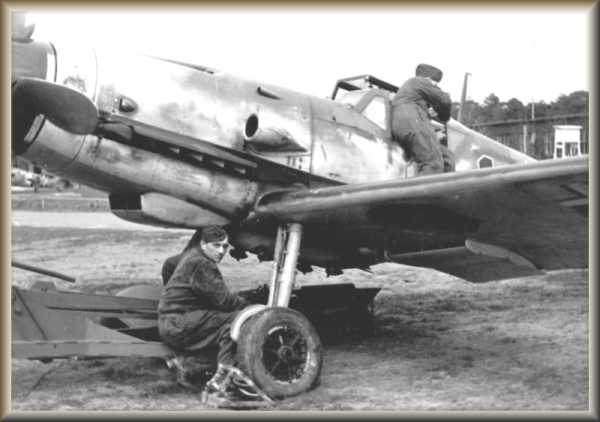
Messerschmitt Bf 109 G-1
1![]() 5./JG11, Lieutnant Heinz Knoke, Staffelkapitän, April, 1943
5./JG11, Lieutnant Heinz Knoke, Staffelkapitän, April, 1943
in Jever
> ![]()
In May, 1943, 5./JG11

Messerschmitt Bf 109 G-1 Lilo 1
5./JG11, Lieutnant Heinz Knoke, Staffelkapitän, May, 1943
in Jever >
July 28, 1943 5./JG11
On July 28, 1943 Heinz Knoke uses a brand new aircraft with a gun of 30mm firing in the axis. It's a Bf 109 G-6/U4.
August 1943 II./JG11
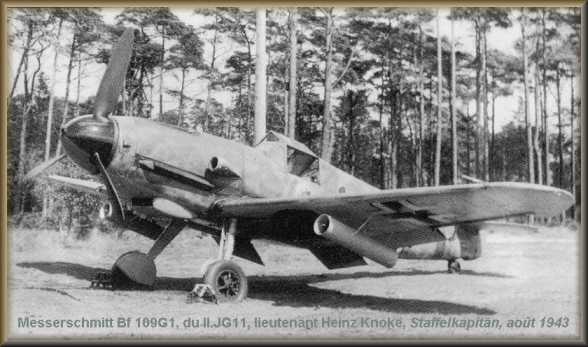 Messerschmitt Bf 109 G-1 1
Messerschmitt Bf 109 G-1 1II./JG11, Lieutnant Heinz Knoke, Staffelkapitän, August, 1943
equiped with 21cm rockets. Note the little red strip on rear of the fuselage.
Jever >
Summer, 1943 II./JG11
Messerschmitt Bf 109 G-6/U4 R6 1II./JG11, Lieutenant Heinz Knoke, Staffelkapitän, Summer,1943
equiped with two 20 mm guns in gondolas. Note the little red strip on rear of the fuselage.
Jever >
On August 17, 1943, Knoke put his aircraft down in a belly_landing, his 109 G is destroyed.
On september 27, 1943, Knoke is shot down and his 109 G is destroyed.
On October 4, 1943, Knoke is shot down and his 109 G is destroyed.
On October 10, 1943, Knoke put his aircraft down in a belly_landing, his 109 G is damaged in 75 %.
On January 4, 1944, Knoke is shot down and his 109 G is destroyed.
On January 30, 1944, Knoke put his aircraft down in a belly_landing, his 109 G is damaged in ?
March, 1944 II./JG11
Messerschmitt Bf 109 G-6II./JG11, Lieutenant Heinz Knoke, Staffelkapitän, March,1944.
Note the Erla Haube Canopy with the long radio antenna type.
This is the unique photo in Heinz Knoke's albums of such a type of plane.
Wunstorf >
Knoke didn't made any other picture of his planes after march 1944, probably because the times became
hard on spring 1944. He was wounded on April 29, and came from convalescence only to participate to
the end of the Normandy Battle in France in the second half of August 1944.
On March 8, 1944, Knoke put his aircraft down in a belly_landing, his 109 G is damaged in ?
He takes an aircraft of 4./JG11.
On April 28, 1944 Knoke says he received a new type of plane with Méthyl and water injection in its cylinders...
... For Knoke's 109 with methanol injection, the type was probably a converted G5 / G6 as well as the power-driven model AS that was put into service around this time; the G14 appearing during the following summer (jean-pierre Ablard ' LILO ' Sun May 14 00:10:12 2000)The AS engine is a DB605A equipped with a bigger size compressor than the DB603 which improved restoring (7800m) and so high altitude performance. This hybrid engine is the immediate predecessor of the DB605D which equipped the G10 version and K4 from October, 1944.
The greater height of re-establishment (the cruise height of " Dicke Auto " was very close to the height of re-establishment of DB605A-5700m) allowed the plane to do without the device GM1 (useful above the re-establishment) which was dangerous when impacted by ball or shell and adopt the WM50 (useful below the re-establishment) with a simple mixture of water and alcohol presenting little danger and improving performance. Increased speed was of the order of 30 to 40km / hour for a 109 (less for a power-driven FW190), so G6 saw its speed passing from 630 to 660 kph; for an AS the speed bordered 670-680km / hour (this depended on the state of the engine, the cell and on the temperature or pressure of the air as well as altitude).
The first AS equipped aircraft was the G6 (new and in retrofit) and maybe some G5s (the engine being available in April, 1944), these engines having risen then in series culminating with the G14.... The assembly of the device WM50 entered service around the same time; yet certain aircraft were able to receive AS without the WM50...
I ignore the exact meaning of the letter S; several hypotheses circulate on its nature, however the most plausible is that S means Sonder (special in German) which would indicate tinkering with the engine (these engines often being obtained from existing engines in revision and modified in the centres of maintenance)... (jean-pierre Ablard)
On April 29, 1944, Knoke is shot down and his 109 destroyed.
Normandy Battle in France in the second half of August 1944.
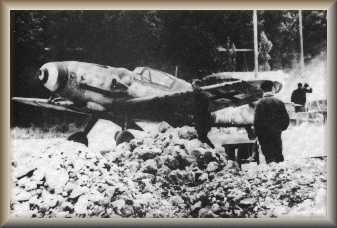
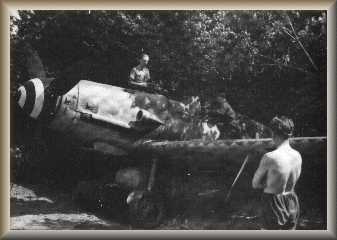

Become a commander of the III. / JG1, Knoke is shot down on August 28, 1944 and his 109 G-6 destroyed.
This aircraft had to carry the new badge of the III. / JG1 :
The propeller's pan was to be black with a white spiral.
(Cf. delivers JG1 p271 testimony of a team member of Knoke : Ulrich Wagner " 4".)

